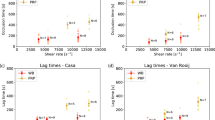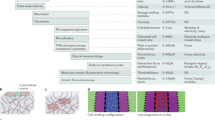Abstract
Although the Chandler loop model has been used in various in vitro flow studies, there is a lack of guidance on the selection of the appropriate sample volume. The questions of how to determine the appropriate sample volume and its effect on blood activation have not been fully addressed. This study proposes a new criterion for determining sample volume and defines a time-averaged wall shear stress equation for this model. In vitro experiments were performed to investigate the implications of sample volume on blood cell activation in the presence of model stent. Experimental results indicated that in the absence of a stent and for shear stress up to about 56 dyn/cm2, platelet activation was independent of volume and shear. On the other hand, the formation of platelet–leukocyte aggregates was affected by volume as well as the presence of a stent. Doubling blood volume for the same stent resulted in a twofold decrease in platelet microparticle formation and platelet–leukocyte aggregation. These results demonstrate the importance of selecting appropriate sample volume for the Chandler loop model, since it influences blood activation parameters, especially platelet–leukocyte aggregation formation, which can play an important role in material-induced thrombosis. These results have significance for in vitro screening of materials for biocompatibility.





Similar content being viewed by others
References
Abe, R., et al. Pulsatile to-fro flow induces greater and sustained expression of tissue factor RNA in HUVEC than unidirectional laminar flow. Am. J. Physiol. Heart Circ. Physiol. 300(4):H1345–H1351, 2011.
Austin, L. R., and J. D. Seader. Fully developed viscous flow in coiled circular pipes. Aiche J. 19(1):85–94, 1973.
Bechtel, J. F., et al. Leukocyte depletion during cardiopulmonary bypass in routine adult cardiac surgery. Interact. Cardiovasc. Thorac. Surg. 12(2):207–212, 2011.
Chandler, A. B. In vitro thrombotic coagulation of the blood; a method for producing a thrombus. Lab. Investig. 7(2):110–114, 1958.
Chang, L. J., and J. M. Tarbell. A numerical study of flow in curved tubes simulating coronary arteries. J. Biomech. 21(11):927–937, 1988.
Chang, X., and M. Gorbet. The effect of shear on in vitro platelet and leukocyte material-induced activation. J. Biomater. Appl. 28(3):407–415, 2013.
Christensen, K., et al. Coagulation and complement activation. Biomaterials 22(4):349–355, 2001.
Craciunescu, O., and L. Moldovan. Designing bio-inspired composite materials for medical applications. In: Nanocomposites and Polymers with Analytical Methods, edited by J. Cuppoletti. Rijeka: InTech, 2011, pp. 309–334.
Fujisawa, N., et al. Fluid dynamics of a textured blood-contacting surface. J. Biomech. Eng. 123(1):97–105, 2001.
Fung, Y. C. Biodynamics: circulation, Vol. xi. New York: Springer, p. 404, 1984.
Fuzaylov, S. Y., and V. L. Serebruany. Amount of paraformaldehyde for sample fixation markedly affects the quality of platelet assessment by flow cytometry: experience from two clinical trials. Thromb. Res. 99(6):643–644, 2000.
Gardner, R. A. An examination of the fluid mechanics and thrombus formation time parameters in a Chandler rotating loop system. J. Lab. Clin. Med. 84(4):494–508, 1974.
Glagov, S., et al. Hemodynamics and atherosclerosis. Insights and perspectives gained from studies of human arteries. Arch. Pathol. Lab. Med. 112(10):1018–1031, 1988.
Gorbet, M. B., and M. V. Sefton. Leukocyte activation and leukocyte procoagulant activities after blood contact with polystyrene and polyethylene glycol-immobilized polystyrene beads. J. Lab. Clin. Med. 137(5):345–355, 2001.
He, X., and D. N. Ku. Pulsatile flow in the human left coronary artery bifurcation: average conditions. J. Biomech. Eng. 118(1):74–82, 1996.
ISO. ISO 10993-12:2002 Biological Evaluation of Medical Devices—part 12: Sample preparation and reference materials. Geneva: International Standards Organization, 2012.
Katritsis, D., et al. Wall shear stress: theoretical considerations and methods of measurement. Prog. Cardiovasc. Dis. 49(5):307–329, 2007.
Li, W., and R. L. Webb. Fouling characteristics of internal helical-rib roughness tubes using low-velocity cooling tower water. Intern. J. Heat Mass Transf. 45:1685–1691, 2002.
Lin, M. C., et al. Shear stress induction of the tissue factor gene. J. Clin. Investig. 99(4):737–744, 1997.
Malarstig, A., and A. Siegbahn. The intersubject variability of tissue factor mRNA production in human monocytes- relation with the toll-like receptor 4. Thromb. Res. 120(3):407–413, 2007.
Matic, G. B., et al. Whole blood analysis of reticulated platelets: improvements of detection and assay stability. Cytometry 34(5):229–234, 1998.
Mitchell, M., and M. R. King. Shear-induced resistance to neutrophil activation via the formyl peptide receptor. Biophys. J. 102:1804–1814, 2012.
Nerem, R. M., and W. A. Seed. Coronary artery geometry and its fluid mechanical implications. In: Fluid Dynamics as a Localizing Factor for Atherosclerosis, edited by G. Schettler, R. M. Nerem, H. Schmid-Schönbein, H. Mörl, and C. Diehm. New York: Springer, 1983, pp. 51–59.
Oyane, A., et al. Preparation and assessment of revised simulated body fluids. J. Biomed. Mater. Res. A 65(2):188–195, 2003.
Pant, S., et al. The influence of strut-connectors in stented vessels: a comparison of pulsatile flow through five coronary stents. Ann. Biomed. Eng. 38(5):1893–1907, 2010.
Robbie, L. A., et al. Thrombi formed in a Chandler loop mimic human arterial thrombi in structure and RAI-1 content and distribution. Thromb. Haemost. 77(3):510–515, 1997.
Rochier, A., et al. Laminar shear, but not orbital shear, has a synergistic effect with thrombin stimulation on tissue factor expression in human umbilical vein endothelial cells. J. Vasc. Surg. 54(2):480–488, 2011.
Shen, F., et al. Threshold response of initiation of blood coagulation by tissue factor in patterned microfluidic capillaries is controlled by shear rate. Arterioscler. Thromb. Vasc. Biol. 28(11):2035–2041, 2008.
Shin, H. Y., S. I. Simon, and G. W. Schmid-Schonbein. Fluid shear-induced activation and cleavage of CD18 during pseudopod retraction by human neutrophils. J. Cell. Physiol. 214(2):528–536, 2008.
Sinn, S., et al. A novel in vitro model for preclinical testing of the hemocompatibility of intravascular stents according to ISO 10993-4. J. Mater. Sci. Mater. Med. 22(6):1521–1528, 2011.
Soeberg, H. Viscous flow in cuved tubes-I. Velocity profiles. Chem. Eng. Sci. 43(4):855–862, 1988.
Srokowski, E. M., and K. A. Woodhouse. Evaluation of the bulk platelet response and fibrinogen interaction to elastin-like polypeptide coatings. J. Biomed. Mater. Res. A 102(2):540–551, 2014.
Tepe, G., et al. Thrombogenicity of various endovascular stent types: an in vitro evaluation. J. Vasc. Interv. Radiol. 13(10):1029–1035, 2002.
Touma, H., I. Sahin, T. Gaamangwe, M. B. Gorbet, and S. D. Peterson. Numerical investigation of fluid flow in a Chandler loop. J. Biomech. Eng, 2014. (in press).
Wever, D. J., et al. Electrochemical and surface characterization of a nickel–titanium alloy. Biomaterials 19(7–9):761–769, 1998.
Zhao, X. M., Y. P. Wu, H. X. Cai, R. Wei, T. Lisman, J. J. Han, Z. L. Xia, and P. G. de Groot. The influence of the pulsatility of the blood flow on the extent of platelet adhesion. Thromb. Res. 121:821–825, 2008.
Acknowledgments
This work was supported by the Natural Sciences and Engineering Research Council of Canada, Ontario Graduate Scholarship and the University of Waterloo. We wish to acknowledge the help of Miriam Heynem for collecting blood samples and the help of volunteers. The authors also thank John Medley for reviewing the manuscript.
Conflict of interest
Tidimogo Gaamangwe, Sean D. Peterson and Maud B. Gorbet declare that they have no conflict of interest.
Human studies
No human studies were carried out by the authors for this article. All procedures followed were in accordance with the ethical standards of the responsible committee on human experimentation (institutional and national) and with the Helsinki Declaration of 1975, as revised in 2000 (5). Informed consent was obtained from all participants for being included in the study.
Animal studies
No animal studies were carried out by the authors for this article.
Author information
Authors and Affiliations
Corresponding author
Additional information
Associate Editor Keefe B. Manning oversaw the review of this article.
Rights and permissions
About this article
Cite this article
Gaamangwe, T., Peterson, S.D. & Gorbet, M.B. Investigating the Effect of Blood Sample Volume in the Chandler Loop Model: Theoretical and Experimental Analysis. Cardiovasc Eng Tech 5, 133–144 (2014). https://doi.org/10.1007/s13239-014-0179-5
Received:
Accepted:
Published:
Issue Date:
DOI: https://doi.org/10.1007/s13239-014-0179-5




